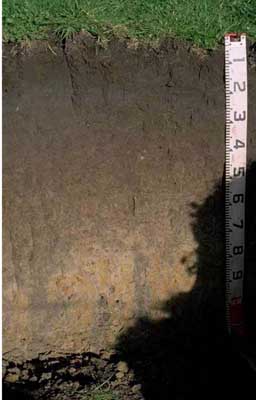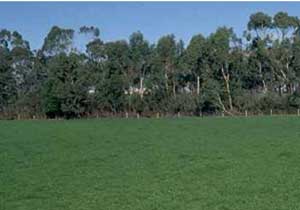SW32
|
| SW32 |  Bleached-Mottled, Mesotrophic, Grey KUROSOL (very thick loamy surface) Melacic-Mottled? | |
| Kawarren | |||
| Undulating rises within rolling hills | |||
| Tertiary - Dilwyn Formation. | |||
| Lower slope | |||
Horizon | Depth (cm) | Description | ||
A11 | 0-15 | Very dark brown (10YR2/2); light fine sandy clay loam; weak coarse blocky, parting to weak medium blocky structure; pH 5.8: | ||
A12 | 15-35 | Very dark greyish brown (10YR3/2); light sandy clay loam; apedal massive structure; pH 5.2: | ||
A21 | 35-60 | Brown (10YR5/3), sporadically bleached; sandy loam (heavy); apedal massive structure; contains a few (2-5%) quartz fragments; pH 5.1: | ||
A22 | 60-80 | Pale brown (10YR6/3); sandy loam; apedal massive structure; contains very few (2%) rounded quartz coarse fragments (2-5 mm); pH 5.3: | ||
A3 | 80-100 | Very dark grey (10YR3/1) with brownish yellow (10YR6/8) mottles; sandy loam; apedal massive structure; contains a few (5%) rounded quartz fragments (2-5 mm); pH 5.5: | ||
B21 | 100+ | Light brownish grey (10YR6/2) with brownish yellow (10YR6/8) mottles; fine sandy light clay; pH 5.3. | ||
| Management considerations | ||||
| Strong texture contrast between the surface soil and the subsoil is a very important soil feature. This can have a major effect by reducing and/or redirecting the internal drainage and restricting root growth beyond the upper horizons. Options include reduced tillage, improving organic matter content and altering the subsoil through artificial drainage (ripping, mole drainage) and/or chemical amelioration (gypsum) to improve structure. Bleached A2 horizons (or subsurface soils) are a major feature of many of soils within the Corangamite CMA region. They are an indication of restricted drainage, poor soil structure (often massive) and low organic matter, nutrient and water holding capacity, nearly always in conjunction with a restrictive soil below such as a clayey soil or a pan (eg. coffee rock). These bleached horizons may act as conduit for subsurface flow, particularly on sloping ground. If the soil is dispersive then gypsum application would be suitable, while increasing organic matter and maintaining vegetative cover is important. Acidic surface soils (topsoil) are often associated with sandy surfaces due the lack of base minerals and may or may not have organic matter (humose or peaty surfaces). Their acidic nature restricts the uptake of certain nutrients as well as intolerance for some plant species (due in part to the increasing mobilisation of aluminium and manganese). The application of lime is the main method of increasing the pH, reducing toxic levels of nutrients to plants while increasing the availability of nutrients such as calcium, potassium and molybdenum. Hardsetting surface and subsurface soils (A1 and A2) are another key feature of many of the texture contrast soils in the CMA. These soils usually have medium to heavy textures and may be sodic (and therefore dispersive), often with low liquid limits (change from solid, plastic to liquid quickly). Water (and gas) movement and root growth is restricted in this soil. Improvement of soil structure through increased organic matter would be useful, and addition of gypsum where sodic would be beneficial. Bringing this material to the surface is likely to contribute to surface sealing and increase erosion susceptibility. Mottled subsoils are common and are an indication of periodic waterlogging, particularly if the mottles are pale (low oxygen conditions). Some brighter mottling may be due to past soil mixing and clay alluviation. Improved drainage, with the application of gypsum for sodic subsoils may be beneficial. Acidic subsoils generally occur on acidic parent material or where there has been sufficient leaching of the soil. These subsoils affect nutrient availability, creating a nutrient imbalance and the potential for aluminium and manganese toxicity. Deficiencies of calcium, potassium and molybdenum are likely. Where the acidity is deep, acid tolerant plants are a practical option, while increasing the pH may be preferable by applying lime. Strong texture contrast between the surface soil and the subsoil is a very important soil feature. This can have a major effect by reducing and/or redirecting the internal drainage and restricting root growth due to greater resistance, gas and water throttles as well as associated chemical deterrents to growth. Options include reduced tillage, improving organic matter content and altering the subsoil through artificial drainage (ripping, mole drainage) and/or chemical amelioration (gypsym) to improve structure. | ||||
Analytical data
Site SW32 | Sample depth | pH | EC | NaCl | Ex Ca | Ex Mg | Ex K | Ex Na | Ex Al | Ex acidity | FC (-10kPa) | PWP (-150kPa) | KS | FS | Z | C | |
Horizon | cm | H2O | CaCl2 | dS/m | % | cmolc/kg | cmolc/kg | cmolc/kg | cmolc/kg | mg/kg | cmolc/kg | % | % | % | % | % | % |
A11 | 0-15 | 5.8 | 5 | 0.18 | N/R | 5.4 | 1.8 | 0.1 | 0.2 | N/R | N/R | 29.6 | 13.9 | 19 | 47 | 11 | 13 |
A12 | 15-35 | 5.2 | 4.4 | 0.12 | N/R | 1.1 | 0.9 | 0.05 | 0.05 | N/R | N/R | 18.2 | 5.4 | 22 | 54 | 9 | 12 |
A21 | 35-60 | 5.1 | 4.4 | 0.11 | N/R | 0.6 | 0.7 | 0.05 | 0.05 | N/R | N/R | 18 | 4.6 | 23 | 55 | 10 | 11 |
A22 | 60-80 | 5.3 | 4.5 | 0.07 | N/R | 0.4 | 0.4 | 0.05 | 0.05 | N/R | N/R | 13.6 | 2.5 | 24 | 58 | 11 | 7 |
A3 | 80-100 | 5.5 | 4.6 | 0.08 | N/R | 0.6 | 0.9 | 0.05 | 0.05 | N/R | N/R | 16.3 | 4 | 22 | 57 | 11 | 10 |
B21 | 100+ | 5.3 | 4.5 | 0.12 | N/R | 1.7 | 3.1 | 0.1 | 0.2 | N/R | N/R | 25.8 | 11.6 | 18 | 44 | 8 | 30 |



